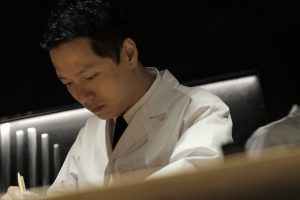Q&A with local chef, Moon Kyung Soo
31 May 2017
1. When did you become a chef?
I started cooking at the age of 18 in South Korea before I joined the military.
2. What was your inspiration to become a chef?
When I started working in a kitchen, I was just making fries. It was very uninspiring. I read an article in the newspaper about a Japanese Sushi Master working in South Korea. He spoke about how cooking Japanese food was like creating from your heart. It was such a personal experience. I thought it was beautiful that it came from the heart, the warmth of the chef’s hands, straight to the guests’ hand, mouth then tongue. There are no fry pans, no plates, there is just trust. I went to that chef and asked him for a job. He wouldn’t take me straight away, and then I went into military school for two years where I worked in the kitchen. As soon as I finished, I went straight back to him and told him that I could work full-time. He agreed, and took me on as an apprentice.

IMAGE CREDIT: Courtesy of Kisumé
3. When did Kisumé open?
Kisumé opened on May 15, 2017. It’s been so exciting to be able to share with our guests something we have been working on for a long time.
4. What are the benefits of having a restaurant located at such a prestigious and unique location on Flinders Lane, directly behind the T&G Building?
The Flinders Lane precinct has evolved significantly in the last five years. It is great to have our restaurant in this vibrant and bustling food hub of Melbourne. Flinders Lane is a destination for both locals and tourists; it’s very beneficial to be able to have that organic foot traffic.
5. What sort of clientele do you serve at the restaurant?
Kisumé is spread across three levels, and it really caters to all sorts of clientele. Our restaurant is both walk-in and we take reservations. During the day we have a lot of locals, tourists and corporates working within the CBD, and in the evening we serve guests from far and wide. Kisumé is lucky to boast two private dining rooms, a Chablis bar and two restaurant spaces. Depending on the type of experience our guests are after, we are able to cater for functions, private events, groups of friends, business meetings or solo diners at the sushi bar.
6. What’s your favourite menu item?
My favourite item on the menu is sushi. To me, it’s the best of the best. Sushi is simple, natural and pure. Specifically, tuna is my favourite seafood to work with when making sushi. It is a very versatile fish. You can eat it raw or cured, you can grill or blanch it. Tuna has the right balance of fat content so it’s always tender and has a lot of flavour.
7. What is the most popular item on the menu?
The most popular item on the menu thus far is definitely the Crispy Truffles with Wagyu Beef, Mozzarella and Truffle Miso. It has three stages of pleasure. The wagyu; the melted mozzarella on the inside; and the delicious truffle miso to dip. Three times lovely!
8. If you could open one restaurant overseas, where would it be and why?
I just moved to Melbourne to open Kisumé with The Lucas Group. I don’t think I’ll be moving again. It is very exciting for me to now call Melbourne home and to share this new restaurant with everyone.
9. What is the most unique dish you’ve created in your career?
Truffle Kanpachi. I created this dish when I was living and working in Singapore. I made a special truffle soy and we would sell more then 1,000 per day. Locals and tourists came from far and wide to try this dish.
10. Can you tell us about Kisumé? What can we expect from this restaurant?
Kisumé [kiss-oo-meh] means ‘a pure obsession with beauty’. Kisumé is a contemporary Japanese restaurant with a sushi bar and restaurant residing on the ground floor and basement levels, whilst Kuro Kisumé sits on the first floor. Kuro Kisumé (meaning black) includes The Table, a unique omakase-style dining experience seating just 12, two private dining rooms with a similar bespoke offering, plus the Chablis Bar, the first such bar in Australia.
Guests can expect dishes that draw on the purity and exacting nature of Japanese food but are uniquely Australian (nearly 100 per cent of the menu features produce from Australia and New Zealand). Seafood is, of course, a highlight.
MASTER IMAGE CREDIT: Courtesy of Kisumé